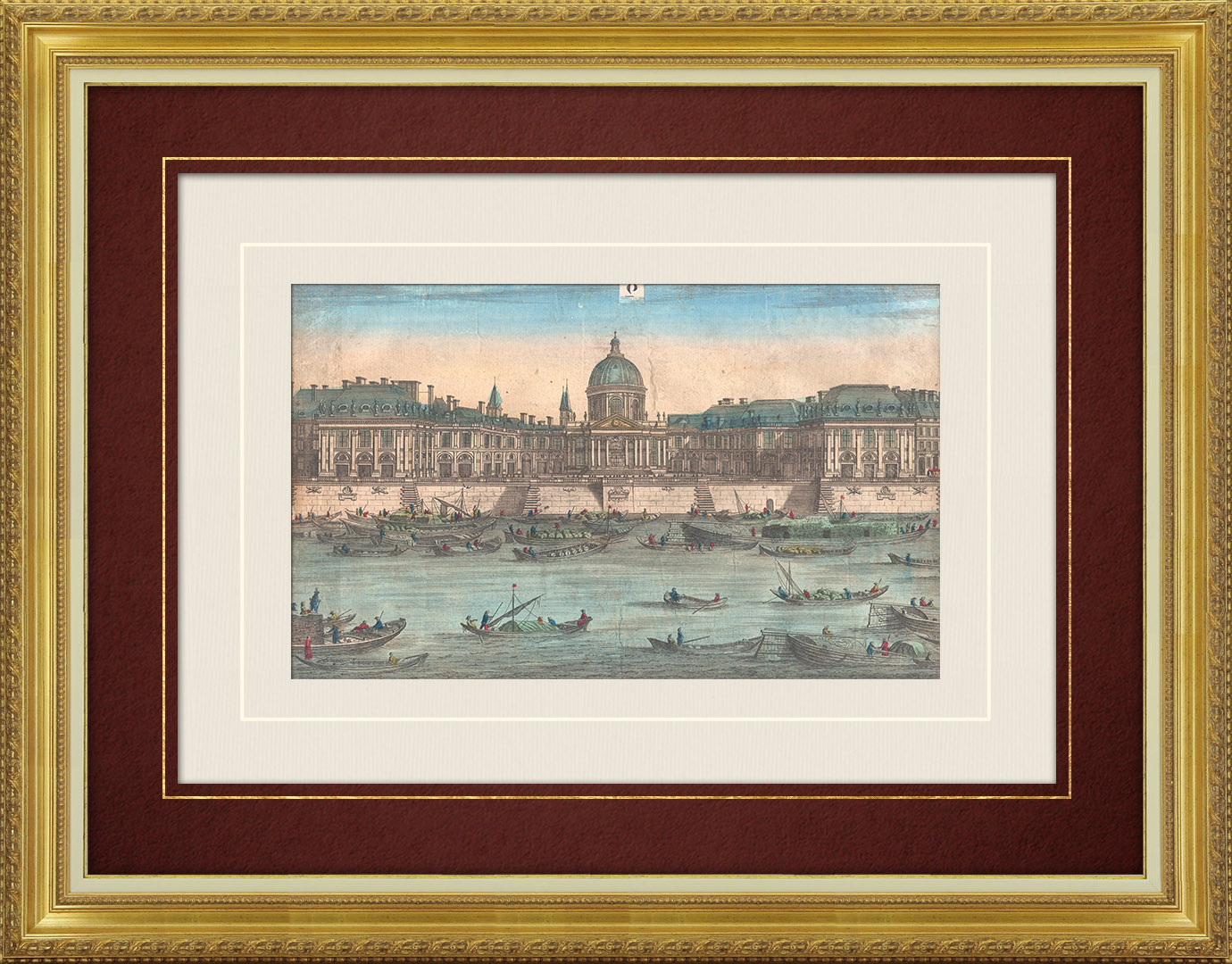
Original title
Vue perspective du College des Quatre Nations.
Description
XVIIIth century optical view in original watercolors. Original copper plate engraving on laid paper heightened with watercolor at that time. Published in Paris circa 1780, depicting a view of the Collège des Quatre-Nations - Paris (France).
During the 18th Century, several renowned establishments in Paris, London (England), Augsburg (Germany) and Bassano (Italy) were specialized in the creation of these optical views. They could be viewed alone or through a zograscope, a wooden foot surmounted by a lens which enlarged the image and accentuated the perspective effect. They could also be placed in optical boxes, the spectator then looked inside the box through the lens. This distraction was greatly appreciated in the 18th Century in the salons of the bourgeoisie and the nobility as in the countryside thanks to the hawkers.
These etchings are nowadays exhibited in museums around the world and extremely appreciated by collectors and decorators for their historical interest and their high decorative value.
Condition report
Find more artworks related to these topics :
This strong water etching is listed in these categories :
The name of the college alludes to the four nations of students at the medieval Parisian university. It was not intended for students of the historical university nations, but for those coming from territories which had recently come under French rule through the Peace of Westphalia in 1648 and the Treaty of the Pyrenees in 1659.
Jean-Baptiste Colbert, who was one of five executors of Mazarin's estate, contrived to get the college built, appointing Louis Le Vau as the architect. Le Vau, who at the time was also working on the south wing of the Cour Carrée of the Palais du Louvre, proposed that the college be placed directly across the river on the Left Bank, so that the sovereign Louis XIV would have a fine view of it from his future apartments. The site was available because of the planned demolition of the Tour de Nesle and adjacent moat and wall of Philippe Auguste. Le Vau's quickly drawn plans were pronounced quite beautiful by the king, and construction began in 1662 and continued up to Le Vau's death in 1670, when it was taken over by his draftsman, François d'Orbay. The college opened in 1688. In accordance with Mazarin's will, his tomb is in the college chapel.
The Galerie Napoléon is pleased to propose to you this strong water etching printed 244 years ago (around 1780).
As for all the antique prints in our catalogue, this optical view Vue perspective du College des Quatre Nations. datant de 1780 is dispatched worldwide within 24H in a Secured packaging, accompanied by its certificate of authenticity guaranteeing the name of the artists (draughtsman, engraver, editor), the impression process used (Strong water) and its date (1780).
In order to guarantee a perfect conservation in time, this strong water etching is dispatched, ready to be framed, under museum quality color passepartout (manufactured without acid in the pulp for a neutral pH) on a cream mountboard made from carton bois (also acid free & neutral pH), in a luxurious portfolio.
At the apogee of the mode for optical views, between 1750 and 1790, four European cities specialized in their edition: Paris (France), London (England), Augsburg (Germany) and Bassano (Italy).
Optical views are prized in very different social circles : pleasant recreation in aristocratic salons, the views are admired in beautiful and richly decorated optical boxes which are real works of art. The show was transformed into a real scientific experiment. But the optical views also entertained the people who were in a hurry when a hawker set up a box on a market and began to narrate the extraordinary events that had taken place in a more or less distant and inaccessible country.
There are three categories in the production of optical views.

With more than 20 years experience and a catalogue of more than 40.000 antique prints, drawings and historical documents dating from the 14th to the 19th century, the Galerie Napoléon, parisian antique dealer's gallery, is one of the world references in the field of antique prints,etchings and antique graphic arts.
In addition to thousands of impassioned of antique prints throughout the world, the Galerie Napoléon is honoured to count among its customers : national archives, museums, historical monuments and important home designer companies. All attracted by the extraordinary diversity of its catalogue and the quality and speed of its services.
This experience allows us to guarantee to each one of our customers the authenticity of the antiques in our catalogue and the shipment of their orders within 24 hours.

Customize for free the color of your museum quality bevel cut edge passepartout (acid free & neutral pH) among a color chart of 23 shades.
This option will be offered to you free of charge in the cart.
All our antiques can be shipped worldwide. The orders are dispatched within 24H in a secured packaging.
The Galerie Napoléon offers free shipping for all orders over 50EUR for France, 70EUR for all EU destinations and 90EUR for worldwide destinations.
For orders below these amounts, the shipping costs are 8EUR for France, 12EUR for all EU destinations and 17EUR for worldwide destinations.























